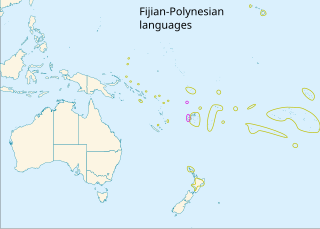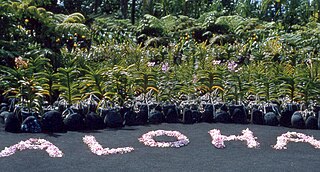Related Research Articles

Polynesian mythology encompasses the oral traditions of the people of Polynesia together with those of the scattered cultures known as the Polynesian outliers. Polynesians speak languages that descend from a language reconstructed as Proto-Polynesian – probably spoken in the Tonga and Samoa area around 1000 BC.
Atua are the gods and spirits of the Polynesian peoples such as the Māori or the Hawaiians ; the Polynesian word literally means "power" or "strength" and so the concept is similar to that of mana. Today, it is also used for the monotheistic conception of God. Especially powerful atua included:

Kaʻaʻawa is a small community and census-designated place (CDP) located in the windward district of Koʻolauloa, City & County of Honolulu on the island of Oʻahu, Hawaiʻi, United States. As of the 2010 Census, the total population for Kaʻaʻawa was 1,379. In Hawaiian, kaʻaʻawa means "the wrasse (fish)". From the Hawaiian spelling Kaʻaʻawa it is seen that each a is pronounced separately and distinctly, set apart by the two ʻokinas: or.

The Polynesian languages form a genealogical group of languages, itself part of the Oceanic branch of the Austronesian family.
The music of Polynesia is a diverse set of musical traditions from islands within a large area of the central and southern Pacific Ocean, approximately a triangle with New Zealand, Hawaii and Easter Island forming its corners. Traditional Polynesian music is largely an inseparable part of a broader performance art form, incorporating dance and recital of oral traditions; most literature considers Polynesian music and dance together. Polynesian music expanded with colonial European contact and incorporated instruments and styles introduced through a process of acculturation that continues to the present day. Although the European tradition of hymn-singing brought by Christian missionaries was probably the most important influence, others are evident; Hawaii's influential kī hōʻalu music incorporated the Spanish guitar introduced in the late 19th century, and later introduced the steel guitar to country music. Hip hop and R&B influences have created a contemporary Urban Pasifika music genre with a strong Polynesian identity and supported by the annual Pacific Music Awards in New Zealand.

Aloha is the Hawaiian word for love, affection, peace, compassion and mercy, that is commonly used as a simple greeting but has a deeper cultural and spiritual significance to native Hawaiians, for whom the term is used to define a force that holds together existence.

Native Hawaiians are the indigenous Polynesian people of the Hawaiian Islands.

Hōkūleʻa is a performance-accurate waʻa kaulua, a Polynesian double-hulled voyaging canoe. Launched on 8 March 1975 by the Polynesian Voyaging Society, it is best known for its 1976 Hawaiʻi to Tahiti voyage completed with exclusively traditional navigation techniques. The primary goal of the voyage was to explore the anthropological theory of the Asiatic origin of native Oceanic people as the result of purposeful trips through the Pacific, as opposed to passive drifting on currents or sailing from the Americas. DNA analysis supports this theory. A secondary project goal was to have the canoe and voyage "serve as vehicles for the cultural revitalization of Hawaiians and other Polynesians."
Kahana may refer to:
Polynesian culture is the culture of the indigenous peoples of Polynesia who share common traits in language, customs and society. The development of Polynesian culture is typically divided into four different historical eras:

The culture of the Native Hawaiians encompasses the social behavior, institutions, and norms practiced by the original residents of the Hawaiian islands, including their knowledge, beliefs, arts, laws, customs, capabilities, and habits. Humans are estimated to have first inhabited the archipelago between 124 and 1120 AD when it was settled by Polynesians who voyaged to and settled there. Polynesia is made of multiple island groups which extend from Hawaii to New Zealand across the Pacific Ocean. These voyagers developed Hawaiian cuisine, Hawaiian art, and the Native Hawaiian religion.

Disney's Polynesian Village Resort is a Disney-owned and operated resort located at the Walt Disney World Resort. It began operation on October 1, 1971 as one of Walt Disney World Resort's first two on-site hotels. The resort has a South Seas theme, and originally opened with 492 rooms. It was designed by Welton Becket and Associates and constructed by US Steel Realty Development. The resort is owned and operated by Disney Parks, Experiences and Products.

Ahupuaʻa O Kahana State Park, formerly Kahana Valley State Park, is located on the windward side of Oʻahu between Kaʻaʻawa and Punaluʻu in the state of Hawaii. The park is located mauka from Kahana Bay. It is Hawaii's only public ahupuaʻa, and it stretches from the sea to the tip of Puʻu Pauao at 2670 feet. It has a tropical climate, and it is one of the wettest areas in Oʻahu, averaging nearly 300 inches per year in parts of the valley. The main purpose of the park is to embrace and teach Hawaiian culture.

The Hawaiian Poi Dog is an extinct breed of pariah dog from Hawaiʻi which was used by Native Hawaiians as a spiritual protector of children and as a source of food.
Woleaian is the main language of the island of Woleai and surrounding smaller islands in the state of Yap of the Federated States of Micronesia. Woleaian is a Chuukic language. Within that family, its closest relative is Satawalese, with which it is largely mutually intelligible. Woleaian is spoken by approximately 1700 people. Woleai has a writing system of its own, a syllabary based on the Latin alphabet.

Polynesian navigation or Polynesian wayfinding was used for thousands of years to enable long voyages across thousands of kilometers of the open Pacific Ocean. Polynesians made contact with nearly every island within the vast Polynesian Triangle, using outrigger canoes or double-hulled canoes. The double-hulled canoes were two large hulls, equal in length, and lashed side by side. The space between the paralleled canoes allowed for storage of food, hunting materials, and nets when embarking on long voyages. Polynesian navigators used wayfinding techniques such as the navigation by the stars, and observations of birds, ocean swells, and wind patterns, and relied on a large body of knowledge from oral tradition.

Polynesia is a subregion of Oceania, made up of more than 1000 islands scattered over the central and southern Pacific Ocean. The indigenous people who inhabit the islands of Polynesia are called Polynesians. They have many things in common, including language relatedness, cultural practices, and traditional beliefs. In centuries past, they had a strong shared tradition of sailing and using stars to navigate at night. The largest country in Polynesia is New Zealand.

There was widespread belief in ghosts in Polynesian culture, some of which persists today. After death, a person's ghost would normally travel to the sky world or the underworld, but some could stay on earth. In many Polynesian legends, ghosts were often involved in the affairs of the living. Ghosts might also cause sickness or even invade the body of ordinary people, to be driven out through strong medicines.

Kahana Bay and Kahana Bay Beach Park are located on the windward side of the island of Oahu in the state of Hawaii.
In Hawaiian mythology, Welaʻahilaninui was a god or the first man, the forefather of Hawaiians. He is mentioned as an ancestor of Hawaiian chiefs in the ancient Hawaiian chant Kumulipo.
References
- ↑ "ITC Kahana". www.identifont.com. Retrieved April 26, 2016.